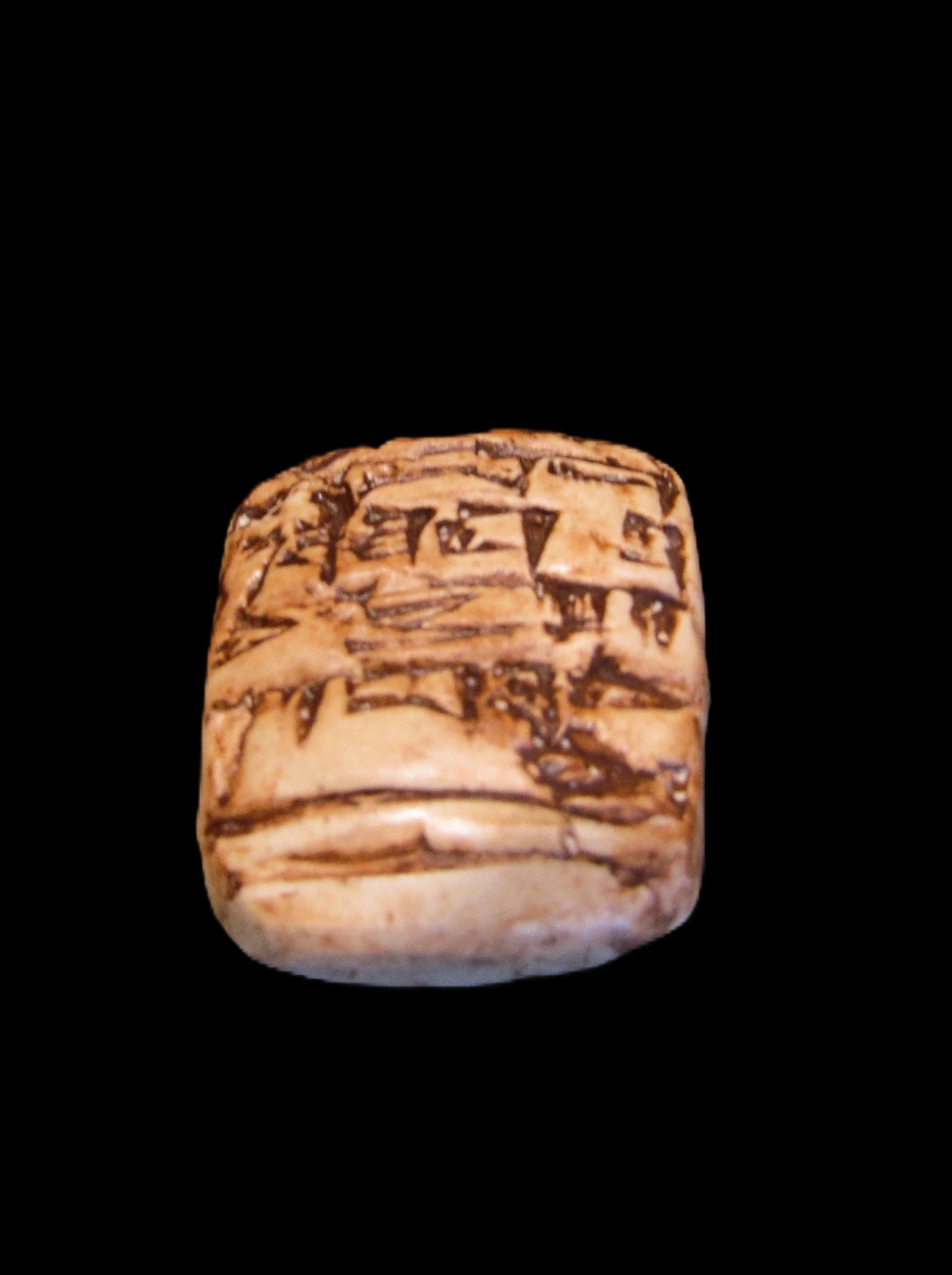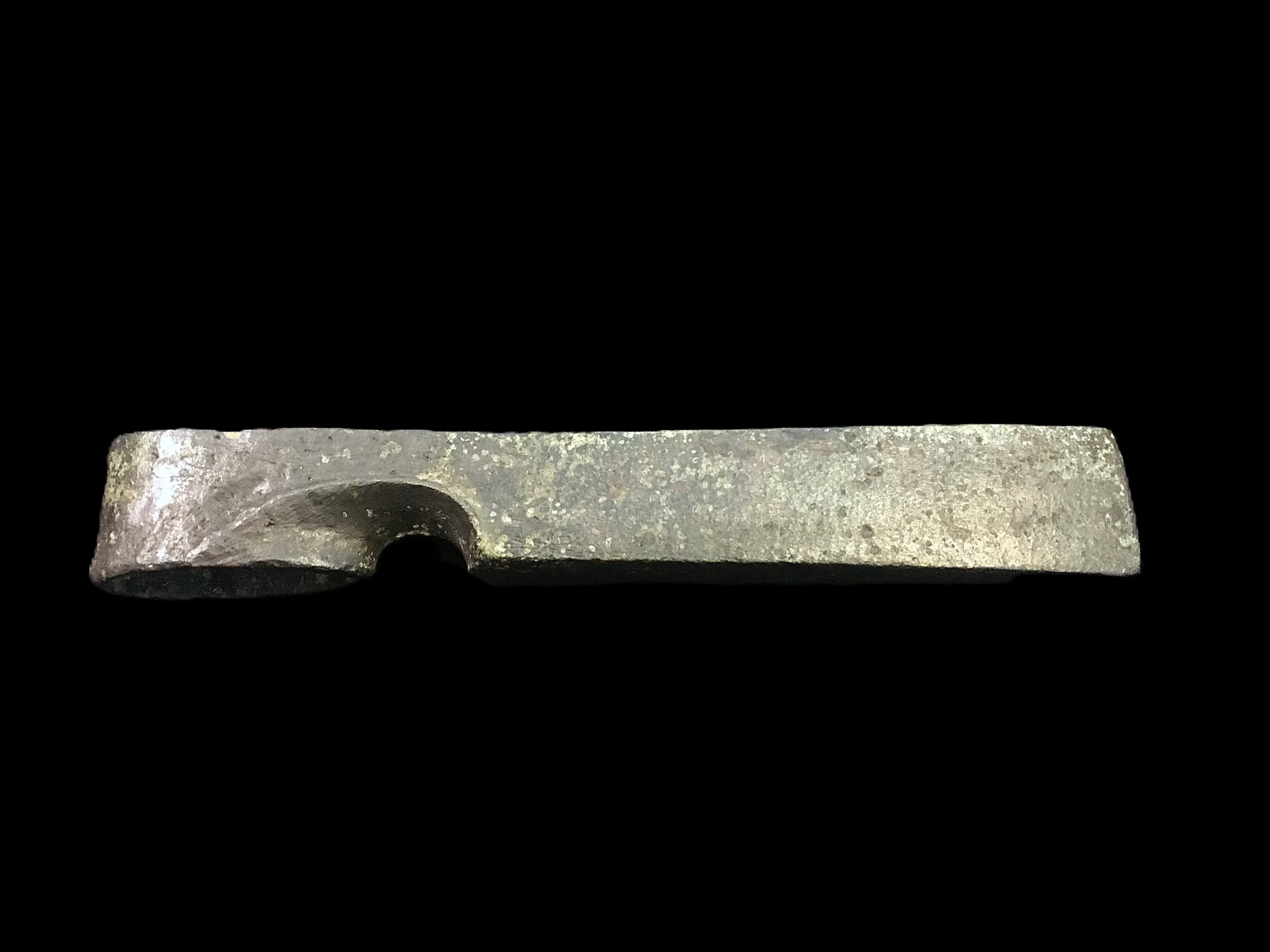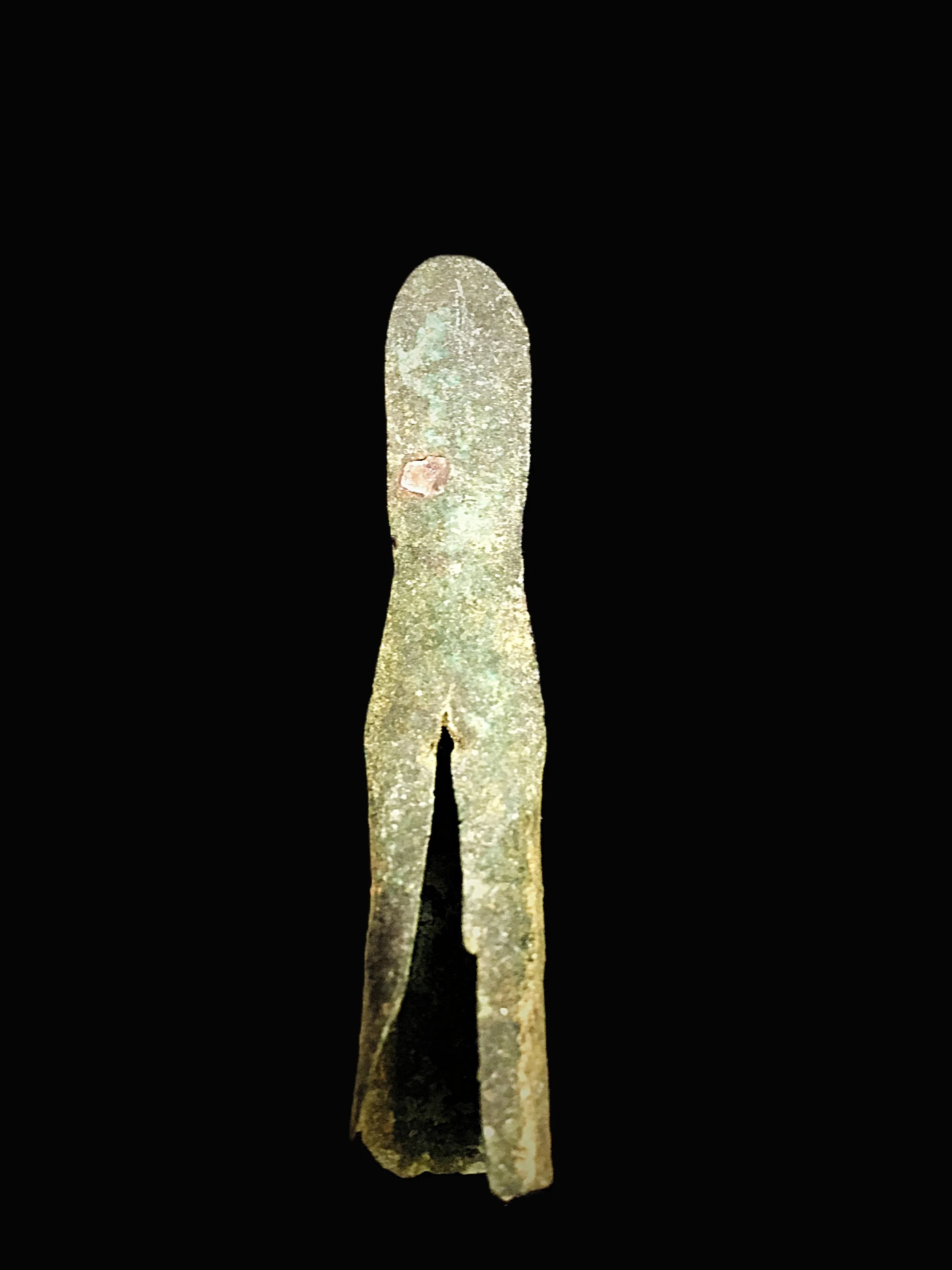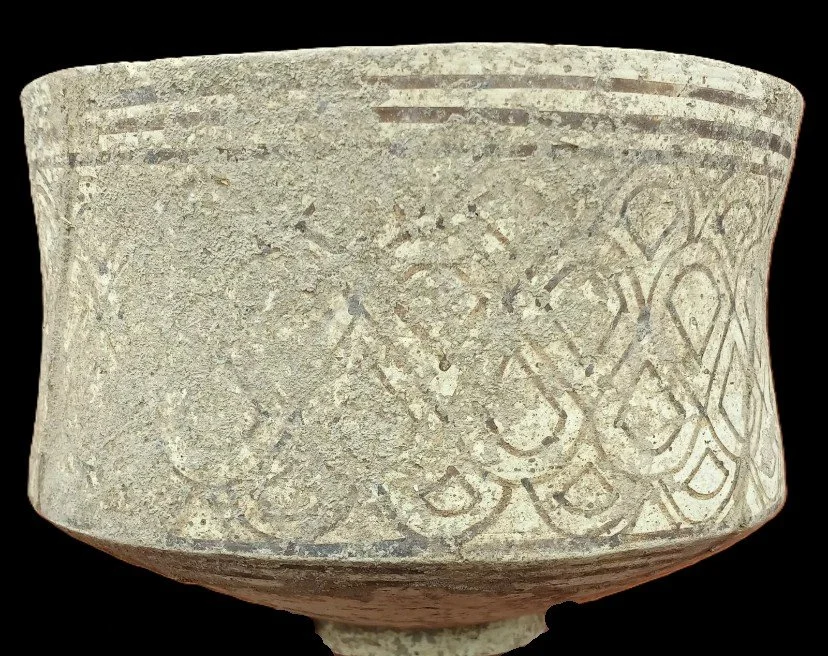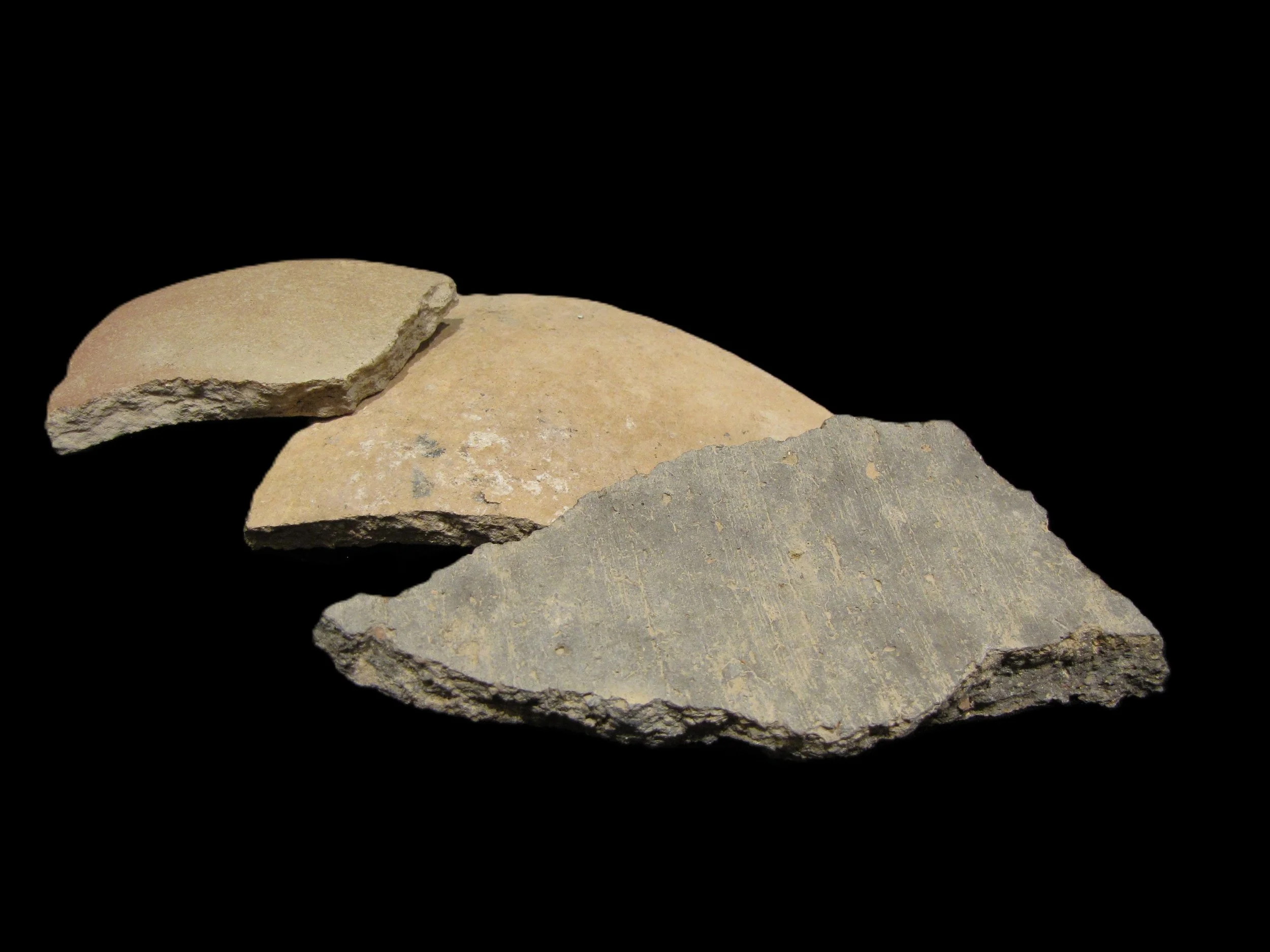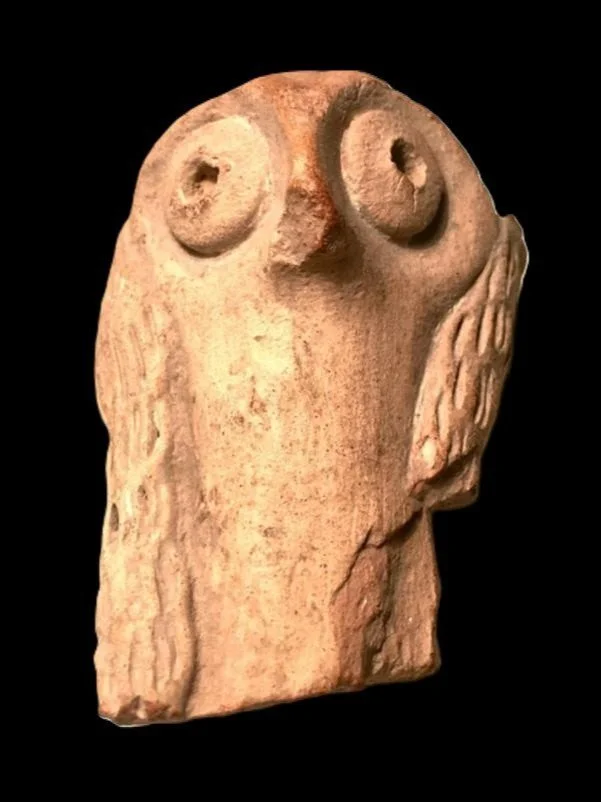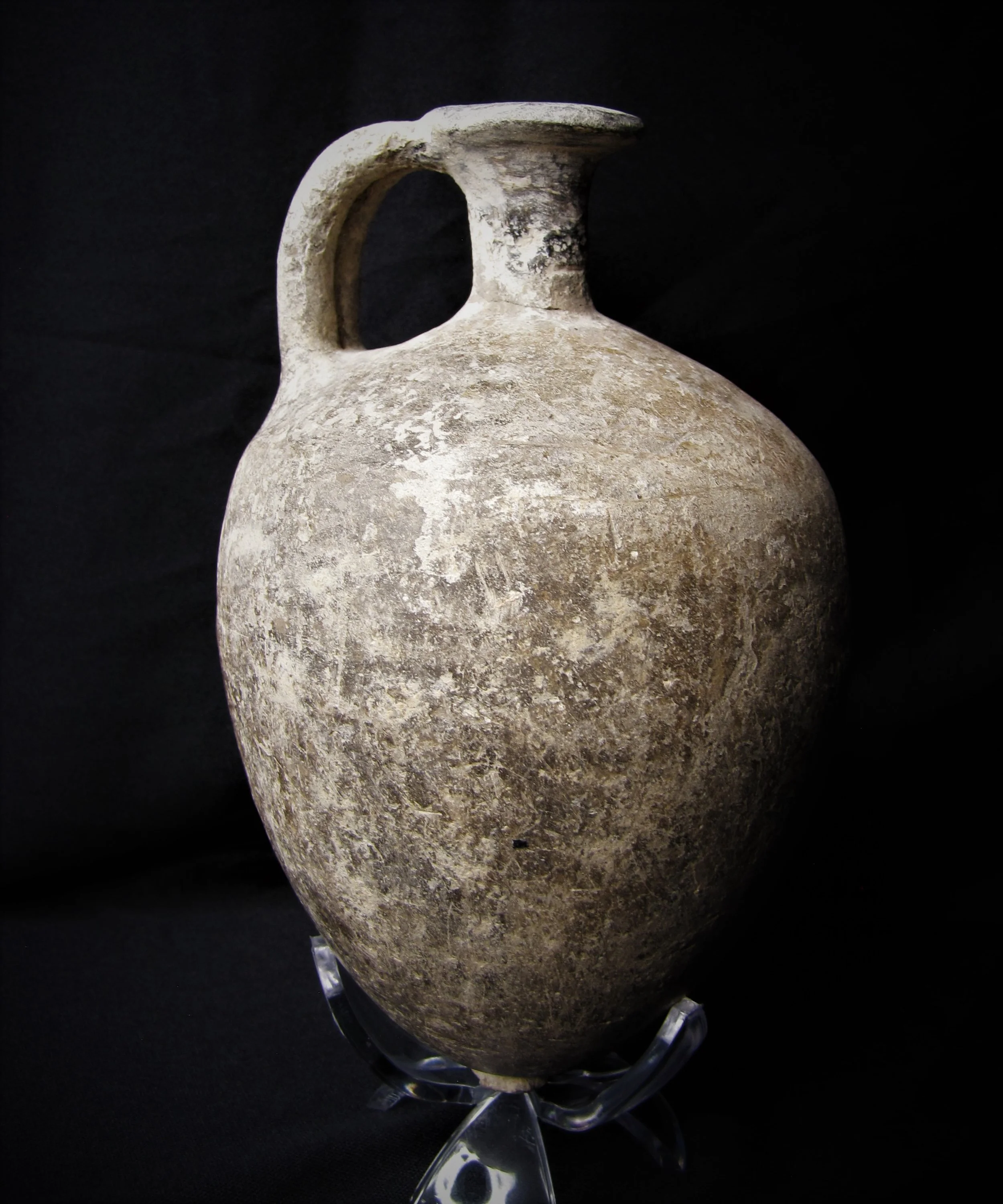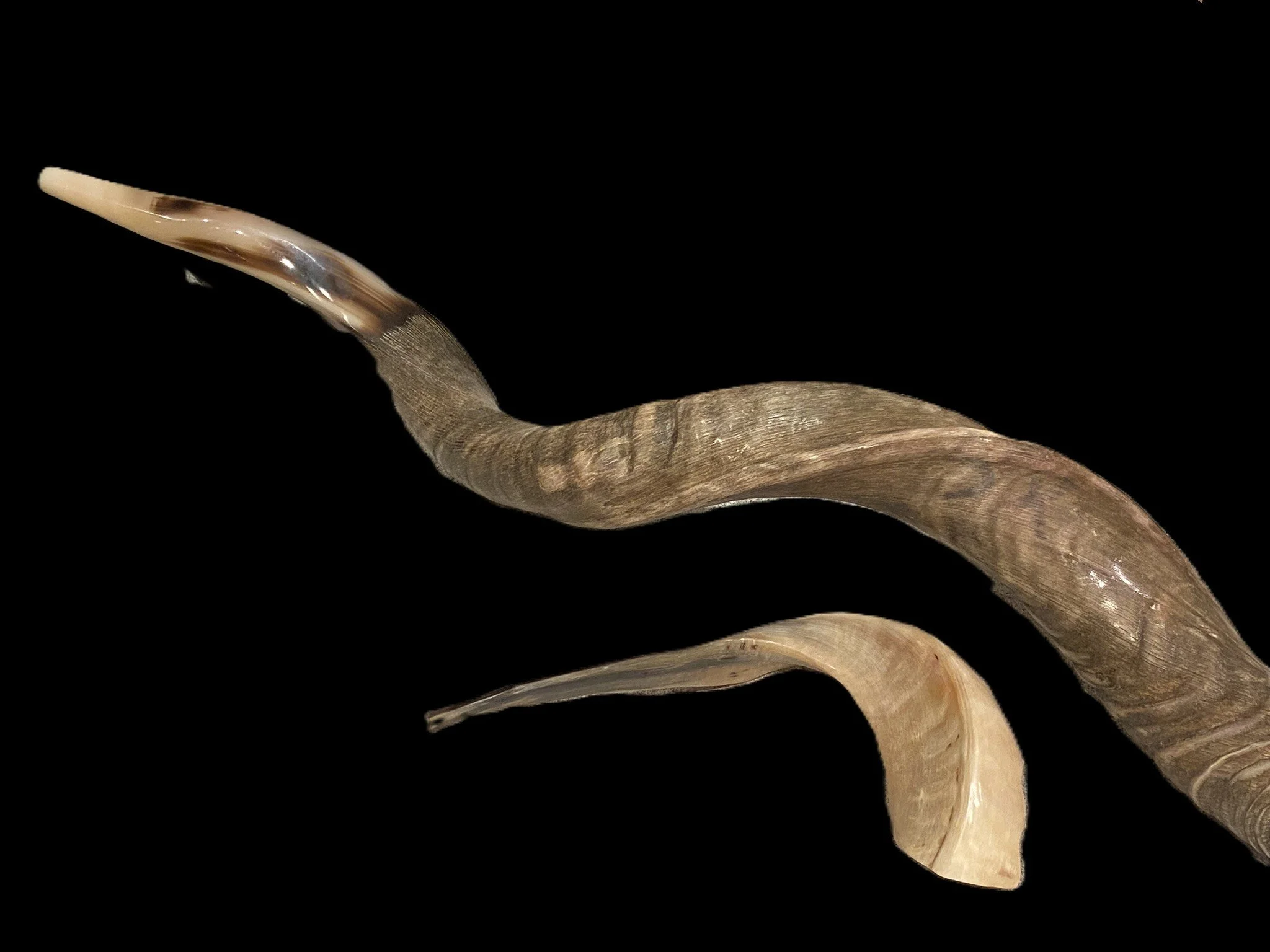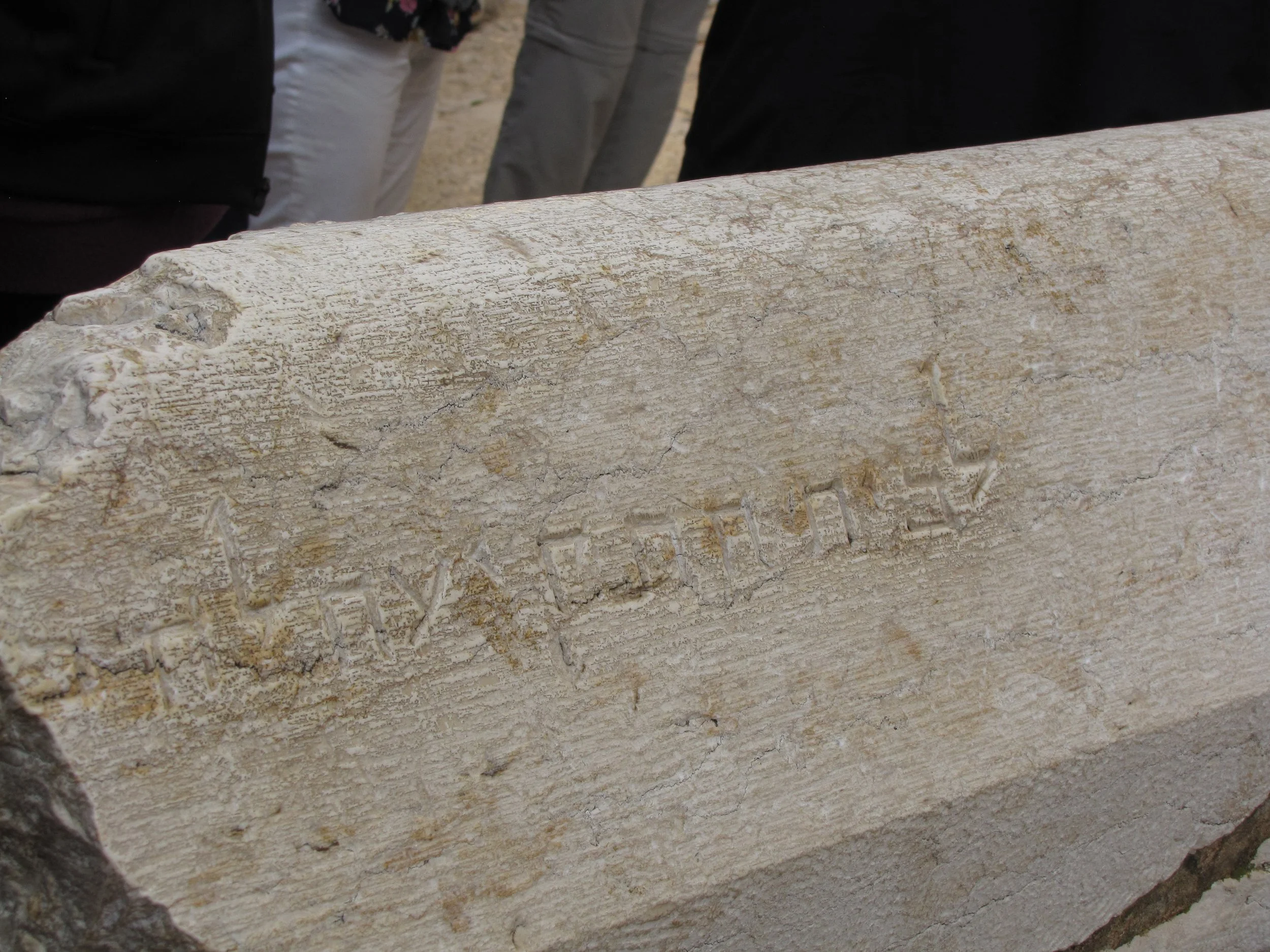Type: Jug
Age: 1550-1130 BCE
Era: Middle to Late Bronze Age
Culture: Canaanite
Excavated: Israel
Reference: Amiran, R. (1969) Ancient Pottery of the Holy Land. Page 263
Type: Pinched Lip Jug
Age: 2250 BC
Era: Bronze Age
Excavated: Jerusalem
This jug comes from the Middle Bronze Age, or the time of the Patriarchs
(circa 2250-1550 BC).
Type: Cypriot Juglet (Bilbil)
Age: 1000 BCE
Era: Late Bronze Age to Iron Age
Culture: Cyprus
Excavated: Israel
Reference: Amiran, R. (1969) Ancient Pottery of the Holy Land. Photo 177, page 173.
Reference: A near identical jar is also displayed at the Haifa Museum in Israel and one in the British Museum.
Imported Cypriot ware (which was manufactured on the island of Cyprus) was very common in Canaan and Israel in the Bronze and Iron Age. In fact, it was a highly coveted type of pottery among wealthier members of society.
Dame Kathleen Kenyon and her team excavated the city of Jericho in the early 20th century. Her conclusion contradicted those of earlier excavator (Garstang). Garstang concluded that the archaeological data from Jericho supports the Biblical narrative, but Kenyon concluded otherwise. She made this conclusion partly on the absence of Cypriot ware which should have been abundant at the time of the Biblical destruction. Later excavator's did, in fact, find Cypriot ware in Jericho, among many other archaeological finds that support the Biblical narrative.
In fact, Garstang noted that the wall of the city had fallen down, as if by an earthquake. There was, however, one single portion of the wall that remained standing. Could this have been the house of Rahab. Unfortunately, this portion of the wall has since deteriorated, but you can read about it in Garstang's excavation notes.
Type: Cypriot Bilbil
Age: 1550-1200 BC
Era: Late Bronze Age
In antiquity, there was a thriving trade between the Island of Cyprus and the coast of Israel/Philistia. The graceful curving form of this vessel conveys the lively spirit of the people from which it came so long ago. We remember that these were individuals who laughed and sang, talked, argued and loved. In appearance they were similar to us, though their vision of the world was vastly different. This jug once, perhaps, held oil, wine, or medicinal opium.
Type: Amorite Plainware Bowl
Age: 2000-1600 BCE
Era: Middle Bronze Age
Culture: Amorite
Excavated: Probably Northern Syria
The Martu (AKA Amorite) were a nomadic group who generally lived in Syria near the Taurus Mountains. Their empire grew, taking over the Akkadian Empire and establishing Babylonia, under King Hammurabi. They are the decedents of Emer, Canaan's son. Canaan was fathered by Ham, the son of Noah.
As noted in the Bible the Amorites were among the tribal clans that the Israelites would need to face as they entered into the Promised Land. During the final stages of the Exodus, the Israelites found themselves warring with Sihon, King of the Amorites who ruled from the city of Heshbon.
The Amorites are attested to in the Amarna Letters (see the Amarna letter replica) as well as other documents, including those that were found in Ugarit and Hatti. One of the Amarna letters was sent to Pharaoh Akhenaten by Rib-Hadda, the ruler of Gubla; a city that was about to be destroyed by the Amarru (Amorite people).
This is a replica of one of the Amarna letters (EA290). This letter was written by the ruler of Jerusalem.
The Amarna letters are a collection of clay letters found in the ancient city of Amarna, in Africa. The city of Amarna was established by Pharaoh Akhenaten in 1346 BC. Akhenaten is a unique pharaoh in that he abandoned all other Egyptian deities, except Aten, the “sun god,” becoming the first Egyptian “monotheist.”
These letters were written from kings and tribal leaders throughout ancient Canaan and Assyria (equating to modern day Israel, Syria, and Lebanon). Many of the letters were written in a desperate plea to seek the pharaoh’s military help in their battle against the invading Apiru (Hapiru). Who were these Apiru? There is a strong case to be made that they were the Hebrews who were taking the Promised Land after the Exodus. Of course, popular scholars refuse to acknowledge this, given their anti-biblical stance. Let’s take a closer look at the reasons why the Apiru where the ancient Hebrews.
Now hold on to your hats, this is a bit of a history lesson. By comparing the written materials from other cultures (e.g. the Assyrians) that provide dates for Israelite and Judean kings, to the information in the Bible, we can firmly come to a date for the building of Solomon’s Temple. That date is 967 BC. The Bible states that Solomon started to build the Temple in the 480th year after the Exodus began. Adding 480 to 967 we get 1447. Because it happened in the 480th year and not after the 480th year, we subtract that year, bringing us to 1446 BC. This date is supported by ancient (non-Biblical) Jewish writings. Given that the Exodus lasted 40 years, that brings us to 1406 when the Israelites started the conquest of the Promised Land. Most people believe that the conquest was quick, but that is not what the Bible implicates. Rather, it took many years and was never fully completed.
Even though the Amarna letters were found in a city founded by Akhenaten in 1346, some of the letters were written to a previous pharaoh who started his reign in 1386 (Amenhotep III). This places the writing of the Amarna letters during the time of the Israelite conquest of the Promised Land. Why is this important? In the Amarna letters, many of the rulers of Canaan wrote to the Pharaoh seeking military assistance in their battle against the Invading Apiru. The Apiru were referred to as a nomadic clan that was bent on taking their land. Oddly, there is no evidence that the Pharaoh sent any military aid, even though Canaan was under Egyptian control at the time. How could the Israelites take such a vast land? In the Amarna letters, we find out that these Apiru were assisted by other clans who were in rebellion against Egyptian Rule. Of course, the Apiru didn’t need assistance, they had the backing of God. As time progressed, we find that the Egyptians lost control of this region. Oddly, we never learn what happened to the Invading Apiru in other writings. Could this simply be because they were eventually called Israelites, who established their presence in the Promised Land?
For more information see the Thutmosis Scarab.
For more information consider reading:
The phenomenal four part series by Dr. Clyde E. Billington in Artifax Magazine.
The article by Doug Petrovich called Amenhotep II and the Historicity of the Exodus Pharoah (Access through the Associates for Biblical Research).
The Article by Christopher Eames called 967 B.C.E.: How the Lynchpin Date for Solomon’s Temple Was Determined at the Armstrong Institute of Biblical Archaeology.
The Amarna Letters by Editor William L. Moran
EA 290 (Translated by William L. Moran)
“Say to the king, my lord: Message of Abdi-Heba, your servant. I fall at the feet of the king, my lord 7 times and 7 times. Here is the deed against the land that Milkilu and Saurdatu did: against the land of the king, my lord, they ordered troops from Gazru, troops from Gimtu, and troops from Qultu. They seized Rubutu. The land of the king deserted to the Hapiru. And now, besides this, a town belonging to Jerusalem, Bit-NIN-URTA, by name, a city of the king, has gone over the the side of the men of Qultu. May the king give heed to Abdi-Heba, your servant, and send archers to restore he land of the king to the king. If there are no archers, the land of the king will desert to the Hapiru. This deed against the land was at the order of Milkilu and at the order of Suardatu, together with Ginti. So may the king provide for his land.”
Some of the Amarna Letters housed in the British Museum.
This is an enlarged replica of the Jacob-Hr seal.
Between 1630 to 1530 BC, Egypt was ruled by foreigners named the Hyksos (see the Hyksos seal for more information). These rulers were Semitic, meaning that they came from the land that is modern day Israel. This is around the time that Jacob’s son Joseph was sold into Egyptian slavery and would eventually become a ruler. Although not much is known of these Hyksos leaders, we know of one very important person because 30 of his royal scarabs have been found. The name, written on the scarab is Yaqub-har. “Yaqub is the exact transliteration of the Semitic name Jacob.” Although we do not know if this is the Jacob, the father of Joseph, the date, location, and people group fits very nicely. In fact, 9 of these Jacob HR scarabs were found in ancient Avaris, in Egypt. Avaris is an ancient Egyptian city that was clearly occupied by a semitic people. Those 9 scarabs were found in a large palace like structure near a large statue of a semitic male. Large sculptures were typically reserved for those in the royal family or high ranking officials. Could this statue be of Joseph?
See the article by archaeologist Christopher Eams, The Hyksos: Evidence of Jacob’s Family in Ancient Egypt? Published on the Armstrong Institute of Biblical Archaeology website.
This is a replica of a Babylonian Cuneiform Tablet
This rounded tablet, with only a scribal signature on the reverse is an Old Babylonian clay document from 1900 BC, the earliest days of Babylon during the reign of the Amorite King Sumu-La-El, son of Sumuabum, who founded the First Dynasty of Babylon in 1894 BC.
This is a replica of a Sumerian cuneiform tablet
This tablet with two lines of inscription on one side and filled on the other is a Sumerian tablet from the 3rd Dynasty of Sumeria, during the reign of Ur-Nammu around 2047-2030 BC.
Type: Black Burnished Jug
Age: 1550-1130 BCE
Era: Middle Bronze Age
Culture: Canaanite
Excavated: Israel
Reference: Amiran, R. (1969) Ancient Pottery of the Holy Land. Drawing 7, Page 123
Type: Canaanite Shelf Bowl
Age: 3000 BCE
Era: Early Bronze Age
Culture: Canaanite
Excavated: Israel
Reference: Amiran, R. (1969) Ancient Pottery of the Holy Land. Drawing 3 page: 53
References to the land of Canaan can be found in the Biblical text as well as the writings of many other cultures. In fact, the earliest non-Biblical mention of Canaan comes from a letter sent to the Mari king around 1800 BCE. The Canaanites are also frequently mentioned in the Amarna Letters; letters found in the ancient city of Amarna, Egypt that were written to Pharaoh Akhenaten (see the Amarna Letters replica). The Bible is rife with references to the Canaanites, and states that the Canaanites stem from Canaan, Noah's grandson. After the Exodus and upon entering into the Promised Land, the Israelites were faced with many challenging battles against many nations. Many of these nations being found in the lineage of Canaan.
The Bible (Numbers 13:29) places the Canaanites near the Mediterranean coast and in the Jordan River Valley.
"When the LORD your God brings you into the land you are entering to possess and drives out before you many nations-the Hittites, Girgashites, Amorites, Canaanites, Perizzites, Hivites, and Jebusites, seven nations larger and stronger than you..."
Deuteronomy 7:1-2
Type: Canaanite Bowl/Cup
Age: 3000 BCE
Era: Early Bronze Age
Culture: Canaanite
Excavated: Israel
Type: Canaanite Duck Bill Axe Head
Age: 2000-1600 BCE
Era: Middle Bronze Age
Culture: Canaanite
Excavated: Unknown
Type: Canaanite Axe Head
Age: 2000-1600 BCE
Era: Middle Bronze Age
Culture: Canaanite
Excavated: Israel
Type: Canaanite Arrow Head
Age: 1800-1200 BCE
Era: Late Bronze Age
Culture: Canaanite
Excavated: Israel
Type: Canaanite Spear Head
Age: 2000-1600 BCE
Era: Middle Bronze Age
Culture: Canaanite
Excavated: Israel
Type: Hyksos Scarab Seal
Age: 2000-1550 BCE
Era: Middle Bronze Age/Second Intermediate Period
Culture: Egyptian/Hyksos/Semitic
Excavated: Unknown
The Hyksos were a very interesting group of people that took power of Lower Egypt right around the time the Bible states that Joseph rose to power in Egypt. Scholars agree that the Hyksos were a Semitic people that came from the Levant (Canaan, Assyria, etc.); but many will not say that they are the decedents of Israel. Given the anti-Biblical bias amongst many scholars and Archaeologists, this is not surprising. Nonetheless, the first century Jewish Historian, Josephus, cites Manetho (a Hellenistic Egyptian Historian ca. 300 BCE) who identifies the Hyksos as Shepard Kings and foreign rulers. Josephus later states that the Hyksos were, in fact, the decedents of Joseph.
In an effort to consolidate power over lower and upper Egypt, Pharaoh Ahmes expelled the Hyksos into the territory that would eventually become Israel.
The greatest concentration of Hyksos archaeological data comes from three cities, one being Tell El-Yahudiyah, which means Mountain of the Jews. Another of the three cities includes Avaris, one of the largest ancient semitic cities in Egypt. According to some archaeologists, there is solid evidence to support the Israelite presence in this city, at that time.
Statue of Thutmoses III in the British Museum
Type: Ancient Egyptian Scarab
Age: 1500-500 BCE
Era: Middle Bronze Age
Culture: New Kingdom to Late Dynastic Egyptian
Excavated: Unknown
This Egyptian Scarab Seal has a cartouche with the name of Pharaoh Thutmose III (right side inside the oval).
As with almost anything in the field of Archaeology there is significant disagreement among scholars. This is most notable, however, when something is related to the Bible. In fact, there is a whole school of archaeology (the minimalists) who have a knack for trying to refute anything that could provide support for the Biblical narrative. Guess who gets the most media attention when topics of archaeology arise. That's right, the minimalists. But there are other scholars, just as well trained and respected, that are not afraid to consider a Biblical connection to archaeological finds. This school, which has become known as the maximalists, provide, in my opinion, compelling evidence for the presence of the Israelites in Egypt and for the Exodus.
Most scholars agree that a semitic group of people infiltrated Egypt in the 18th century BCE. They are recognized as the Hyksos. According to 1st century historian Josephus, who cites an earlier Egyptian historian called Manetho, the Hyksos were foreign rulers, referred to shepherd kings, who came from the Levant (modern day Israel, Lebanon, Syria). The Hyksos capital, now called Tel El Daba, was called Avaris during the time of the Hyksos and at one point, the city of Rameses.
Based upon the Biblical Timeline, Joseph would have arrived in Egypt around 1880 BCE. The Exodus would have occurred 430 years later, in 1446 BCE, the exact time we see a dramatic change in Egyptian prosperity and culture. Also, about 40-60 years before Canaanite kings request military assistance to battle the roaming nomads referred to as the Habiru (see the Amarna letter). Based upon this timeline it can be determined that Thutmose III was the Pharaoh that enslaved the Israelites and his son Amenophis II would have been the pharaoh of the Exodus.
Thutmose II's daughter, Hatshepsut may well have been the queen who saved moses. It is even more intriguing that she was loved by Egyptians for some time, but after her death, she was hated; so much so, that they tried to eradicate any evidence of her existence. Could it be because she raised the child who, by the command and power of God, brought about the desolation of Egypt? It is interesting that a non-Egyptian entered into the royal family that matches the time frame and situation of Moses quite well. His name was Senemnut. A very compelling article about this character and the possible connection to Moses can be found here.
Thutmose IV was pharaoh after Amenophis II, but did you know Thutmose IV was not the first-born child of Amenophis? Why does this matter? Well, the first-born of the Egyptians would have been killed in the plague. The Dream Stele, found between the paws of the Great Sphinx (written around 1401 BCE) suggests that Thutmose IV was not the first-born child but became Pharaoh, nonetheless. We also know that Amenophis II was not the first born, because Egyptian writing indicate that Amenhemet was the Kings eldest son and stepbrother of Amenhotep II. This is why the Pharaoh did not die in the tenth plague.
Thutmose III was renowned for the numerous military campaigns he undertook; however, Amenophis II engaged in very few campaigns. The most notable one, however, was in the Levant where he captured many thousands of slaves. Could this have been to rebuild the slave base that had left in the Exodus.
Let us not neglect to recognize the common use of Moses in the name of the pharaohs, Thutmose being a prime example.
But didn’t the Bible and that movie “The Ten Commandments” tell us that Rameses was the Pharaoh of the Exodus? To answer this, please see the Amarna Letter information regarding the dating of the Exodus. Scholars believe that the reference to the Israelites building the storehouses of Rameses is a later addition. The city of Rameses was formerly known as Avaris, the Capital City when the Israelites were in Egypt. If I were writing about the Southern Salt Lake Valley today, I would not use the name Evansville because people would not know where that is. Rather, I would use the name Lehi, which was formerly known as Evansville. The same thing likely happened with the Bible. Later readers would know the city as Rameses rather than Avaris, thus the name was likely updated.
Type: Oil Lamp
Age: 1800 BCE
Era: Middle Bronze Age
Culture: Canaanite
Excavated: Jerusalem
*On loan from the Llewelyn Collection
The fact that this Oil Lamp was found in Jerusalem and dates to the Early/Middle Bronze Age, it should probably be attributed to the Jebusite Clan. The Jebusites where decedents of Canaan and named after their patriarch Jebus. It was the Jebusites who founded Jerusalem/Salem.
Canaan was the father of Sidon his firstborn, and of the Hittites, Jebusites, Amorites, Girgashites, Hivites, Arkites, Sinites, Arvadites, Zemarites, and Hamathites.
Genesis 10:15-16
And David and all Israel went to Jerusalem, which is Jebus where the Jebusites were, the inhabitants of the land.
1 Chronicles 2:4
Type: Jug
Age: 1400 BCE
Era: Middle to Late Bronze Age
Culture: Canaanite
Excavated: Israel
Type: Small Pyxis Jar
Age: 4000 BCE
Era: Chalcolithic/Early Bronze Age
Excavated in: Hebron
Reference: Amiran, R. (1969) Ancient Pottery of the Holy Land. Photo 43 page: 49 for a near identical pot excavated at Ai.
This small jar, which is about 6000 years old was excavated in Hebron, a very important Biblical city. The Bible tells us that Abraham, Sarah, and David lived in Hebron. In fact, Hebron was where David reigned for the first seven years until he conquered Jerusalem. Today, you can visit the the Tomb of the Patriarchs, which has long been revered as the burial place of Abraham, Isaac, Jacob, Sarah, Rebecca, and Leah.
Type: Clay cup
Age: 1700 BCE
Era: Late Bronze Age
Culture: Ammonite
Excavated: Jordan
** The seller states that this was excavated just south of Ammon Jordan, however the style seems to be very close to those found in the Indus Valley.
Type: Small Jug
Age: 3200-2200 BC
Era: Bronze Age
Excavated: Jerusalem
This small jug was made during the “Old Testament Period.” Found in an excavation site in Jerusalem, this jug would have been used for general purposes. It may have once held wine, water, or some other daily use item.
Type: Ribbed Jug
Age: 3200-2200 BC
Era: Bronze Age
Excavated: Jerusalem
This jug was found in Jerusalem and would have belonged to one of the very early inhabitants of the city.
Type: Pottery Shards
Age: 1500-1200 BC
Era: Late Bronze Age
Excavated: Jericho
The ancient city of Jericho lay about 6 miles from the Jordan River, 7-1/2 miles northwest of the Dead Sea and 14 miles from Jerusalem. A large gushing spring and the fertile plain surrounding the city earned it the distinction, “The City of Palms” (Deuteronomy 34:2; 2 Chronicles 28:15). A major east-west road ran next to the city, intersecting with the Jordan at a ford nearby, making Jericho a strategic crossroads. The city had already been occupied for many centuries before the Israelites arrived. It had an inner wall and an outer fortified wall, several feet think, enclosing about 9 acres of land. To the Israelites entering the Primised Land, Jericho presented a major obstacle. According to the Bible, Joshua and the Israelites crossed the Jordan in the springtime and then celebrated the Passover on the plains outside Jericho, eating some of the fresh grain of the land since it was harvest time (Joshua 3:15-17; 5:10-12). For seven days the Israelites marched around the city, accompanied by priests blowing trumpets. on the seventh day, after their seventh circuit around the city, the priests blew their trumpets, the people shouted, and the walls of the city, as the old song goes, “came a-tumblin’ down.” “Then the people went up into the city, every man straight before him, and they took the city. And they utterly destroyed all that was in the city…with the edge of the sword” (Joshua 6:20-21). The Bible also tells us that the city was burned (Joshua 6:24). It has been noted by archaeologists…”The destruction was complete. Walls and floors were blackened or reddened by fire, and every room was filled with fallen bricks, timbers, and household utensils; in most rooms the fallen debris was heavily burnt, but the collapse of the walls of the easter rooms seems to have taken place before they were affected by fire.” This pottery was taken from the wall at Jericho and the burn marks on the pottery can be clearly seen as noted in the Joshua account.
Type: Broken Idol of Ba'al
Age: 2000-1600 BCE
Era: Middle Bronze Age
Culture: Canaanite
Excavated: Israel
”Like scarecrows in a cucumber patch, their idols cannot speak. They must be carried because they cannot walk. Do not fear them, for they can do no harm-and neither can they do any good.” Jeremiah 10:5
Ba'al was a prominent idol worshiped by many cultures in the Near East. Throughout the Old Testament, the LORD regularly rebukes his people, Israel, when they would worship Ba'al, Ashtaroth, or another foreign deity. Often, the idols were broken as part of a ritual; however, some of the Judean Kings (e.g. Hezekiah), made it a personal goal to destroy and discard these idols.
Type: Broken idol of Astarte or Ashtaroth
Age: 3000 BCE
Era: Early Bronze Age
Culture: Hittite
Excavated: Probably Hattusa
”Like scarecrows in a cucumber patch, their idols cannot speak. They must be carried because they cannot walk. Do not fear them, for they can do no harm-and neither can they do any good.” Jeremiah 10:5
Astarte, Ashtaroth, Aphrodite, and Artemis all reflect the same pagan "goddess" of sex and fertility across the Near East and Europe.
Type: Juglet
Age: 2500 BCE
Era: Early Bronze Age
Culture: Likely Canaanite
Excavated: Israel
Reference: Amiran, R. (1969) Ancient Pottery of the Holy Land. Drawing 10 page: 53
Type: Piriform Jug Tel-El-Yahudiyeh Type
Age: 1700 BCE
Era: Middle Bronze Age
Culture: Canaanite
Excavated: Israel
Reference: Amiran, R. (1969) Ancient Pottery of the Holy Land. Pages: 36-37 and 107
Although this jug does not have the characteristic decorative punctures common to the Tell El-Yahudiyeh Piriform jugs, it does have the shape that was popularized in the region. In fact, production of these piriform jugs may have centered in Tell El-Yahudiyeh, Egypt .
Tell El-Yahudiyeh means Mountain of the Jews and is located in northern (lower) Egypt today. Excavations of the site found a large walled city which was unlike Egyptian walled cities of the time. The difference is likely due to the city being established by the Hyksos, a Semitic group that took control of Lower Egypt during the Middle and Late Bronze Ages. (See the Hyksos seal for more information). Note that Joseph was sold into Egypt in the Middle Bronze Age, thus we have a Biblical attestation as well as archeological evidence of an Israelite presence in Egypt at this time.
According to Anat Chohen-Weinberger of the Israel Antiquities Authority “Tell el-Yahudiya ware refers to a distinct group of pottery named after the site of Tell el-Yahudya in the Egyptian Nile Valley.” The form is not common amongst pottery created by Egyptians. The pottery has been found in the Middle Kingdom (when Joseph would have went to Egypt) throughout the Hyksos Period to the New Kingdom, disappearing around 1530; a bit later than the date of the Exodus. The renowned archaeologist Flinders Petrie believe that the pottery originated outside of Egypt, in the area of Canaan. The primary feature of Tel El-Yahudiyeh Pottery are the puncture marks on the outer surface.
In summary, these jars became popular in norther Egypt during the time that Joseph was in Egypt. They are unlike many pottery types in Egypt at the time. The greatest concentration of these vessels were found in a location called Tel El-Yehudieh which means mountain/mound of the Jews. The area was occupied by semitic people including the Hyksos (see the Hyksos seal for more information), whom became rulers over the norther region of Egypt. Once the Hyksos rule ended, the semitic people were placed into slavery until 1567 BC, the date of the Exodus. It was around this time that these pottery types disappear.
The Hyksos ruled from the city of Avaris which would later be called the city of Pi Rameses. Inside the city, the standard four room houses have been found including a large palace which deviates from the typical Egyptian style. A large statue of a semitic male was found in near the palace; such statues typically being reserved for royalty or high ranking officials. Some believe that this is a statue of Joseph.
This piece is currently being checked by the Israeli Antiquities Authority for Export approval and will probably arrive in late May 2025.
The shofar is a musical instrument of ancient origin made of horn (traditionally that of a ram). It was used for Jewish religious purposes. Shofar blowing is incorporated in synagogue services on Rosh Hashanah and Yom Kippur. The shofar was used to announce holidays and the jubilee year (Leviticus 25:9). It was also used in processions (2 Samuel 6:15; 1 Chronicles 15:28), as musical accompaniment (Psalm 98:6), And included in the temple orchestra (Psalm 150:3). When Joshua and the Israelites surrounded the walls of Jericho, shouted and blew the shofar, the walls came tumbling down (Joshua 6:20). It was commonly taken to war so the troops would hear its distinct sound and know when the battle had begun.
A shofar may not be painted in colors, but it may be carved with artistic designs. A crack or hole in the shofar, affecting the sound, renders it unfit for ceremonial use. Shofars are sometimes plated with silver across part of their length for display purposes, although this invalidates them for use in religious practices. Because the hollow of the shofar is irregular in shape, the harmonics obtained when playing the instruments can vary.
In Jerusalem, archaeologists have found a large stone that had been thrown from the pinnacle of the Temple that reads “Place of the Trumpeting.” It is thought that this stone marked the place where the Levitical priest would blow the trumpet or shofar.
Date: 1700’s
Genuine scroll of the Book of Esther.








